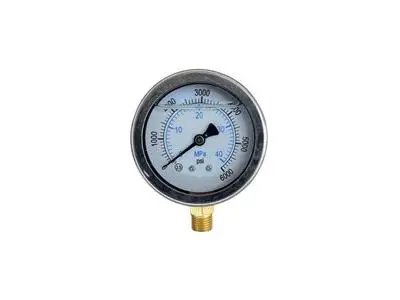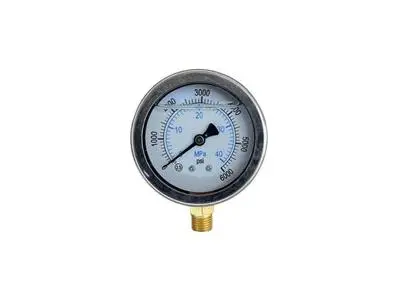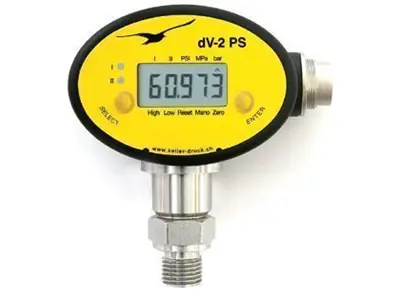What is a Manometer?
A manometer is a measurement device used to measure pressure. It is commonly used to measure the pressure of liquids, gases, or vapors. Manometers are widely used in industrial, laboratory, medical, and various other fields. A manometer measures the pressure of a fluid (usually liquid or gas) at a specific point inside a tube or pipe caused by a pressure source. They typically measure and display pressure values on a rotating dial or digital screen. Manometers are designed for many different types of pressure measurements, so they vary depending on the environment and application they will be used in.
Among the different types of manometers are differential manometers (measuring the difference between two pressures), absolute manometers (referencing atmospheric pressure as zero), and gauge manometers (measuring the value on a pressure gauge). These devices are used in industrial process control, energy production, HVAC systems, laboratory experiments, and many other applications.
What is the Purpose of a Manometer?
Manometers can generally be found in various types such as differential manometers (measuring pressure difference), absolute manometers (referencing atmospheric pressure) and gauge manometers (measuring a specific pressure). The answer to the question 'what does a manometer measure' is that it is a device used to measure pressure and monitor these measurements. Manometers used in measuring the pressure of substances under pressure such as liquids, gases, or vapors play an important role in various industrial, laboratory, and domestic applications. These devices are used in evaluating whether a system is operating properly, ensuring that fluids are flowing correctly, checking filter systems, regulating heating and cooling systems, measuring blood pressure in medical devices, among many other areas. By measuring pressure changes accurately, manometers contribute to the safe, efficient, and effective operation of a system.
Where are Manometers Used?
A manometer is an important measuring device used in various industrial, scientific, and technical applications. Generally, manometers are used to measure and display pressure inside liquids, gases, or vapors. These devices are widely used in various industrial process control, laboratory experiments, energy production, and many other applications. The manometer allows monitoring and regulating the pressure levels in a system, contributing to its operation. This allows for increasing the efficiency of a machine, ensuring safety in energy facilities, regulating HVAC systems, or successfully conducting a laboratory experiment, among various other purposes.
In addition to industrial applications, manometers are frequently used in HVAC systems, laboratories, the medical field, and the automotive sector. In HVAC systems, manometers are used to control and adjust air pressure, while specialized manometers can be used to measure and control pressure in medical devices. In the automotive sector, manometers play an important role in brake systems, tire pressure, and other mechanical applications. They are a critical tool for performing pressure-related measurements and using these measurements to control operations in various industrial, scientific, and technical application areas. Their high accuracy and reliability enable these devices to play a significant role in a wide range of applications.
What are Manometers and Their Types?
Manometers have various applications ranging from industrial settings to laboratory environments. For example, these devices can be used for various applications such as monitoring pressure in pipelines, controlling air compressors, regulating heating and cooling systems, among other uses. Types of manometers come in various forms depending on their intended use and the types of pressure they measure.
Mechanical Manometers: These types of manometers measure pressure directly using a physical change on a measuring device (usually a tube, pipe, or other device). Mechanical manometers can typically measure differential pressure.
Electronic Manometers: These types of manometers measure pressure using sensors and electronic circuits. They display measurement results through a digital screen.
Magnetic Manometers: Magnetic manometers measure pressure by using the movement of magnetic particles in a fluid. Changes in the magnetic field indicate pressure changes.
Aneroid Manometer: This is a type of mechanical manometer usually consisting of a metal casing. Changes in this casing move a lever or indicator to measure pressure. Aneroid manometers can be found in applications such as atmospheric pressure measurement and medical devices.
U-Tube Manometer: This type of manometer includes a tube measuring the pressure difference between two columns. It is often used for differential pressure measurement. Changes in liquid levels indicate pressure difference.
Digital Manometer: This type of manometer measures pressure electronically using sensors and digital displays. They can perform precise measurements and are often preferred for field applications due to their portability.
Instrument Gauge (Tire Pressure Gauge): This is a type of manometer used to measure tire pressure in automobiles. It is usually located on a panel inside the vehicle or within a tube.
Vacuum Manometer: Used for measuring negative pressure (vacuum). They are used especially in vacuum systems, industrial vacuum applications, and laboratories.
Manostat: A type of manometer used to maintain or control a specific pressure value. These devices can automatically control another device to maintain a specific pressure level.
Differential Manometer: Used to measure the difference between two pressures. They are used in applications such as checking air pressure in filters and measuring flow rates in piping systems.
Manometers are designed to meet a wide range of pressure measurement needs. These devices are widely used in industries, energy, healthcare, automotive, and many other sectors.
What is the Operating Principle of a Manometer?
A manometer is a device used to measure pressure changes. This measuring device works by utilizing the relationship between different pressure levels. For example, U-tube manometers measure pressure differences by using changes in the level of liquid inside. Aneroid manometers convert pressure changes into mechanical movement of an indicator using a flexible metal casing. Digital manometers generally measure pressure electronically through sensors and display the results on a digital screen. These various types of manometers have a wide range of applications in industrial, laboratory, and portable devices.
Manometer Prices
Manometer prices can vary depending on a range of factors. These factors include the type of manometer, measurement range, accuracy class, material quality, brand, and manufacturer, among other elements. Also, choosing between a digital or analog manometer can affect prices.
Prices for a simple analog manometer are generally lower, while manometers that are digital, capable of precise measurements, and meet specific industrial standards can be more expensive. Manometer prices can vary from manufacturer to manufacturer and seller to seller, so it is important to check various sources to get pricing for a specific type of manometer. Additionally, by comparing various brands and models, you can find one that fits your budget. You can find information on manometer prices through makinaturkiye.com, where online shopping sites, industrial suppliers, and companies selling measurement devices meet.








